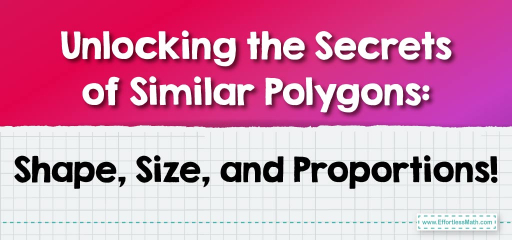Unlocking the Secrets of Similar Polygons: Shape, Size, and Proportions!
Polygons, with their multifaceted edges and intriguing properties, are foundational to the world of geometry. A particularly captivating concept within polygons is similarity. Imagine having two figures that look identically shaped but differ in size. These are called 'similar polygons'. But what makes polygons similar? Let's embark on a journey to unveil the essence of similar polygons, their criteria, and their importance.

Step-by-step Guide: Similar Polygons
Defining Similar Polygons:
Two polygons are considered similar if they have the same shape but possibly different sizes. This implies two main conditions: their corresponding angles are congruent, and their corresponding sides are in proportion.
Criteria for Similarity:
- Angles: Every corresponding angle in one polygon must be congruent to its counterpart in the other polygon.
- Sides: The lengths of corresponding sides of the polygons must be in the same ratio.
Determining the Scale Factor:
The ratio of any two corresponding lengths in two similar geometric figures is called the ‘scale factor’. If one polygon is a scaled version of another, the amount by which it has been scaled is the scale factor. \(\text{Scale Factor} = \frac{\text{Length of a side in the larger polygon}}{\text{Length of the corresponding side in the smaller polygon}} \)
Examples
Example 1:
Triangles \(ABC\) and \(DEF\) have angles measuring \(40^\circ\), \(70^\circ\), and \(70^\circ\) respectively for both. If \(AB = 5 \text{ cm}\), \(BC = 10 \text{ cm}\) and \(DE = 2.5 \text{ cm}\), \(EF = 5 \text{ cm}\), are they similar? If so, what’s the scale factor?
Solution:
Since all corresponding angles are congruent, they are potentially similar. To confirm, let’s check the side ratios:
\( \frac{DE}{AB} = \frac{2.5 \text{ cm}}{5 \text{ cm}} = 0.5 \) and \( \frac{EF}{BC} = \frac{5 \text{ cm}}{10 \text{ cm}} = 0.5 \)
Since the ratios are equal, the triangles are similar with a scale factor of \(0.5\).
Example 2:
Rectangles \(WXYZ\) and \(PQRS\) have widths of \(4 \text{ cm}\) and \(8 \text{ cm}\) and lengths of \(6 \text{ cm}\) and \(12 \text{ cm}\) respectively. Are they similar?
Solution:
For rectangles, the angles are all \(90^\circ\), so only the side ratios need to be checked:
\( \frac{PQ}{WX} = \frac{8 \text{ cm}}{4 \text{ cm}} = 2 \) and \( \frac{QR}{XY} = \frac{12 \text{ cm}}{6 \text{ cm}} = 2 \)
With equal ratios and congruent angles, the rectangles are similar.
Practice Questions:
- Quadrilaterals \(MNPQ\) and \(RSTU\) have sides measuring \(2 \text{ cm}\), \(3 \text{ cm}\), \(4 \text{ cm}\), \(6 \text{ cm}\) and \(4 \text{ cm}\), \(6 \text{ cm}\), \(8 \text{ cm}\), \(12 \text{ cm}\) respectively. Are they similar?
- Two triangles \(GHI\) and \(JKL\) have angles measuring \(45^\circ\), \(45^\circ\), and \(90^\circ\) for both. If \(GH = 7 \text{ cm}\), \(HI = 10 \text{ cm}\) and \(JK = 14 \text{ cm}\), \(KL = 20 \text{ cm}\), are they similar?

Answers:
- Yes, they are similar.
- Yes, they are similar.
Related to This Article
More math articles
- Decimals in Action: How to Master Multiplication and Division
- How to Evaluate Integers Raised to Rational Exponents
- How to Multiply and Divide Fractions? (+FREE Worksheet!)
- Area and Perimeter
- How to Find Reference Angles?
- How to Use Place Value Blocks to Compare Decimals
- How to Be A Great SAT/ACT Math Tutor?
- Top 10 SAT Math Practice Questions
- 4 Best Keyboards for Online Teaching
- How to Score 800 on SAT Math?


























What people say about "Unlocking the Secrets of Similar Polygons: Shape, Size, and Proportions! - Effortless Math: We Help Students Learn to LOVE Mathematics"?
No one replied yet.